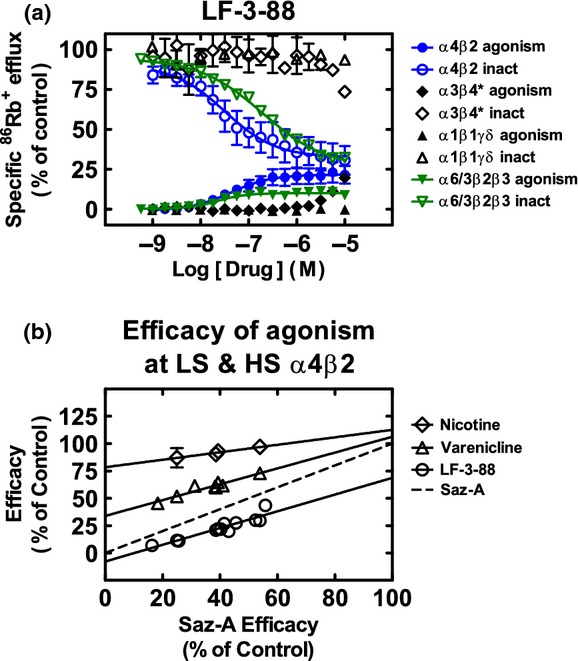Figure 2.

(A) Effects of LF-3-88 at nAChR subtypes. Specific 86Rb+ efflux (ordinate; percentage of control ± SEM) was determined as described in the Materials and Methods for intrinsic agonist activity over a 9.5 min period for compound LF-3-88 at the indicated concentrations (abscissa; log molar scale) on human α4β2-nAChR (●), (α6/3)β2β3-nAChR (▼), α3β4*-nAChR (♦), or α1β1γδ-nACHR (▲) naturally or heterologously expressed by SH-EP1-hα4β2, SH-EP1-h(α6/3)β2β3, SH-SY5Y, or TE671/RD cells, respectively. Also shown are functional inactivation effects of pretreatment for 10 min with the same agents at the indicated concentrations on subsequent agonist action of an EC90 concentration of the full agonist, carbamylcholine (applied in the continuing presence of the indicated agents), acting at α4β2-nAChR (○), (α6/3)β2β3-nAChR (▽), α3β4*-nAChR (♢), or α1β1γδ-nAChR (△). Results are normalized to responses to a fully efficacious concentration of carbamylcholine (see Materials and Methods for details). Nanomolar agonist EC50 values and inactivation IC50 values are provided in Table 2, as are agonism and inactivation efficacies (normalized to those for a full agonist or antagonist, respectively). (B) The unusual characteristic of sazetidine-A being a full agonist at HS α4β2-nAChRs while having zero or nearly zero efficacy at LS α4β2-nAChRs allows the determination of a ligand's efficacies at both HS- and LS-α4β2 in cells expressing a variable mix of the two α4β2-nAChR isoforms. The ordinate intercepts of the linear regressions at a sazetidine-A efficacy (abscissa) of 0% represent the efficacies at LS α4β2-nAChRs, while the ordinate intercepts at a sazetidine-A efficacy of 100% represent the efficacies at HS α4β2-nAChRs. Values and standard errors are reported in Table 2.
